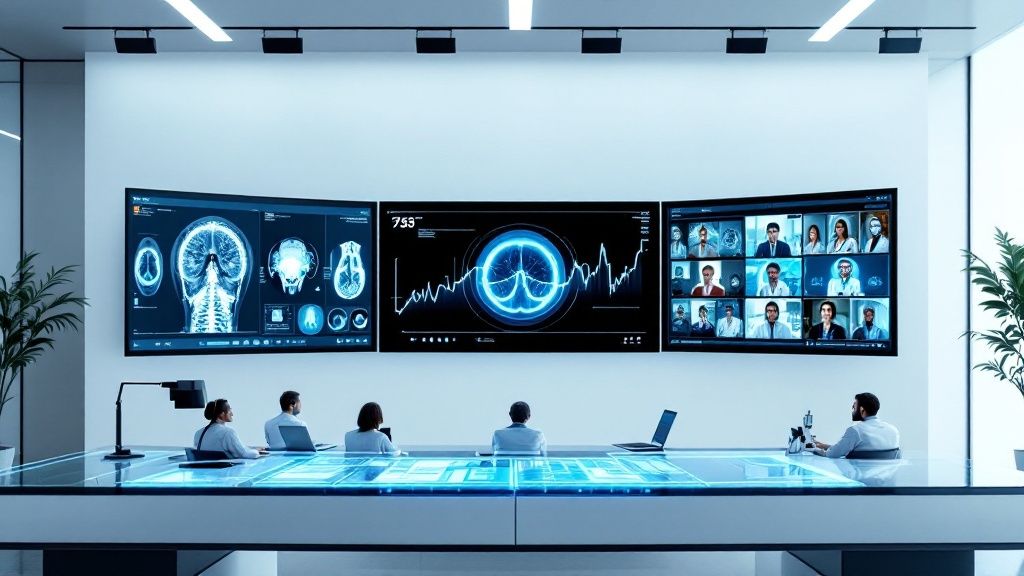Selecting the right teleradiology partner is a critical decision that directly impacts patient care, operational efficiency, and your facility's financial health. The challenge lies in navigating a crowded market where many teleradiology companies offer seemingly similar services. This resource is designed to cut through the marketing noise, providing a detailed, comparative analysis of the fastest-growing providers in 2025. We move beyond generic feature lists to give you an inside look at how these platforms perform in real-world scenarios.
This guide provides an in-depth profile of each company, examining their specific service offerings, from preliminary reads to final interpretations and subspecialty coverage. We will analyze their technology stacks, turnaround times, and pricing models to help you make a well-informed decision. When setting up your teleradiology operations, establishing reliable and cost-effective communication is paramount. Understanding the fundamental pros and cons, such as the advantages and disadvantages of VoIP, can significantly influence your infrastructure choices and overall budget.
Each profile includes practical implementation considerations, screenshots of the user interface, and direct links to their websites. Our goal is to equip you with the necessary information to evaluate each option based on your unique needs, whether you're a rural hospital needing overnight coverage or a large imaging center seeking specialized expertise.
1. RAD365
RAD365 distinguishes itself as one of the fastest-growing teleradiology companies by seamlessly integrating human expertise with advanced technology. With over a decade of experience, it has evolved into a global leader, providing comprehensive diagnostic support to healthcare organizations worldwide. The platform is particularly effective for facilities requiring rapid, high-accuracy interpretations, such as busy emergency departments, imaging centers, and hospitals managing high patient volumes.
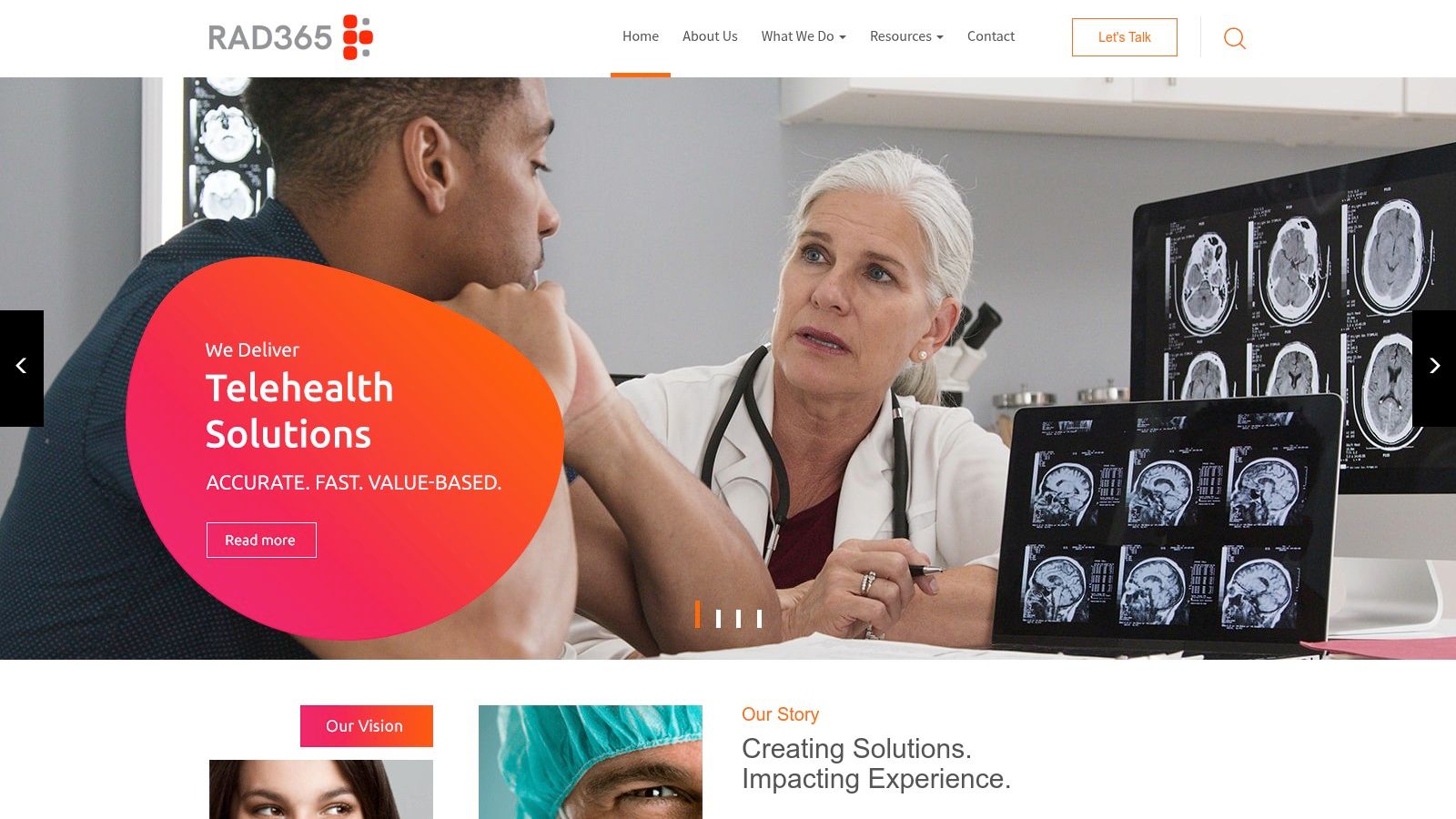
What sets RAD365 apart is its commitment to both speed and precision, underscored by a remarkable 99.99% accuracy rate. This level of quality is maintained through rigorous quality assurance protocols and a global team of over 100 professionals, including certified US and UK radiologists. Their innovative use of AI to automate and streamline radiology workflows is a key differentiator, enhancing efficiency and supporting long-term patient care management. You can explore how RAD365 applies this technology by reading more about their approach to healthcare artificial intelligence.
Key Service Highlights
Exceptional Turnaround Times: RAD365 excels in rapid reporting, delivering emergency reads in as little as 15 minutes and standard reports within 2 hours. This makes it an ideal partner for trauma centers and urgent care facilities that cannot afford delays in patient diagnosis and treatment.
AI-Enhanced Workflow: The platform leverages artificial intelligence not just for image analysis but to optimize the entire diagnostic process. This includes intelligent case routing, preliminary report generation, and flagging critical findings, which significantly reduces the administrative burden on radiologists.
Global Expert Access: Clients gain 24/7/365 access to a diverse pool of board-certified radiologists. This global coverage ensures that expert second opinions and subspecialty consultations are always available, regardless of time zone or location.
Pros and Cons
Strengths | Limitations |
|---|---|
Rapid Reporting: 15-minute emergency and 2-hour standard turnaround times. | Opaque Pricing: Pricing models are not publicly available, requiring a direct consultation for a quote. |
High Accuracy: A 99.99% accuracy rate backed by stringent quality control. | Specialized Focus: Primarily concentrated on teleradiology, which might not suit providers seeking a single, all-in-one telehealth solution. |
Advanced Technology: Innovative use of AI enhances workflow efficiency. | |
Robust Security: Fully HIPAA-compliant systems ensure the highest level of patient data protection. |
Website: https://www.rad365.com
2. vRad (Virtual Radiologic)
As one of the largest and most established teleradiology companies in the U.S., vRad offers unmatched scale and 24/7/365 coverage for hospitals and imaging centers. The platform connects healthcare providers with over 500 U.S.-based, board-certified radiologists, many with subspecialty training. This depth of expertise is crucial for facilities needing reliable after-hours, overflow, or specialized interpretations for complex cases like stroke and trauma.
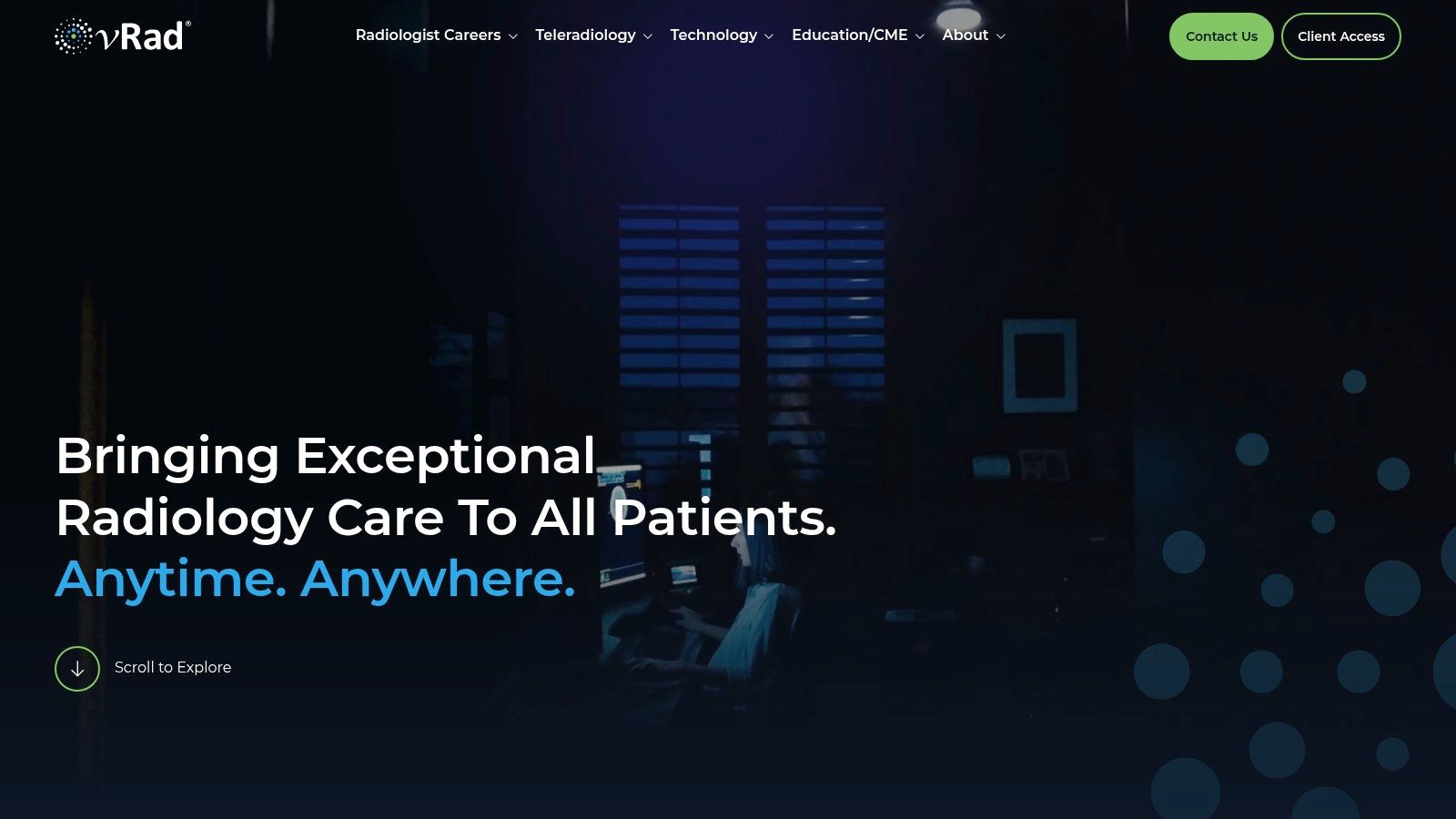
vRad distinguishes itself with a proprietary, AI-enhanced workflow platform designed for speed and accuracy. It integrates seamlessly with existing RIS/PACS systems and delivers structured reports with prior image integration. Client services are extensive, covering everything from implementation and credentialing to billing and analytics, making it a comprehensive, turnkey solution. This robust infrastructure and operational support solidify its position as one of the fastest growing teleradiology companies in 2025.
Key Considerations
Service Model: Offers final and preliminary reads with dedicated subspecialty coverage.
Security: Meets high-security standards with SOC 2 Type II compliance.
Pricing: Custom pricing is provided upon consultation; no public pricing is available.
Implementation: The onboarding process, including contracting and payer enrollment, can be lengthy, requiring advanced planning.
Website: https://www.vrad.com
3. USARAD (Radiology-On-Demand)
As a radiologist-owned and operated teleradiology company, USARAD offers a flexible, physician-led approach to remote radiology services. The platform provides nationwide 24/7/365 coverage with a strong emphasis on rapid turnaround times for both preliminary and final reports. Its services are designed to support imaging centers, mobile imaging providers, and hospitals needing reliable day, night, or subspecialty coverage without the commitment of a large-scale contract.
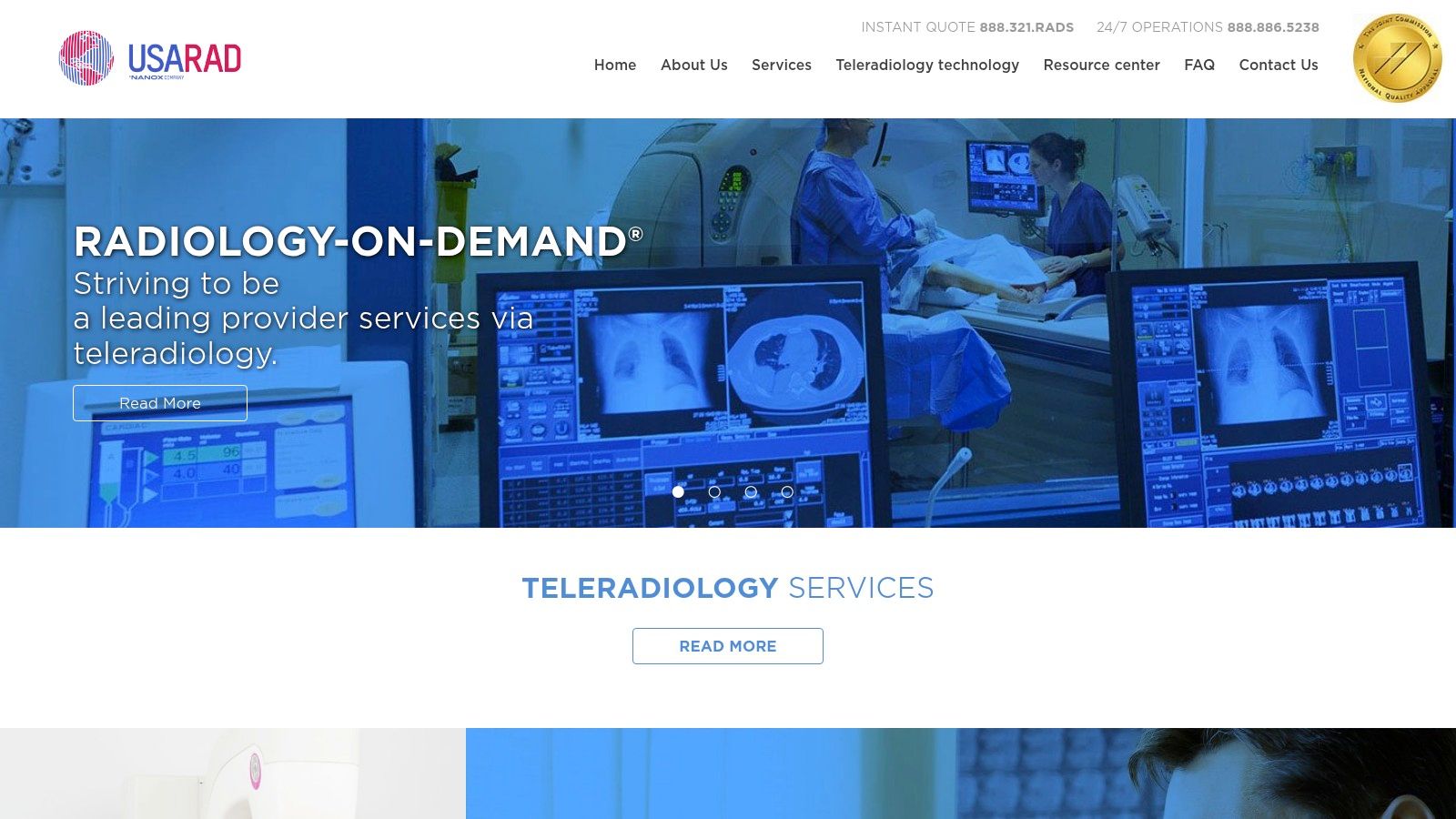
USARAD sets itself apart with its flexible fractional staffing models and a robust, AI-supported workflow that integrates with existing PACS/RIS systems. This structure allows facilities to customize coverage schedules to meet fluctuating demand, from overflow support to dedicated subspecialty reads in areas like neuroradiology or musculoskeletal imaging. The direct involvement of radiologists in operations ensures a focus on clinical quality and collaborative support, making it one of the more agile teleradiology companies poised for growth in 2025.
Key Considerations
Service Model: Provides final and preliminary reads, second opinions, and flexible staffing models.
Security: Complies with HIPAA standards to ensure patient data protection.
Pricing: Pricing is customized based on modality, volume, and required turnaround time; no public rate card is available.
Implementation: The platform is designed for streamlined integration with standard PACS/RIS workflows, but specific timelines depend on the facility’s technical setup.
Website: https://www.usarad.com
4. StatRad
As a radiologist-owned and operated U.S. teleradiology provider, StatRad positions itself as a true extension of existing radiology groups rather than just a service. The company emphasizes a partnership model, providing 24/7/365 coverage with a focus on quality assurance and direct communication. This approach is ideal for hospitals and imaging centers looking for a collaborative partner that aligns with their clinical standards and operational goals.
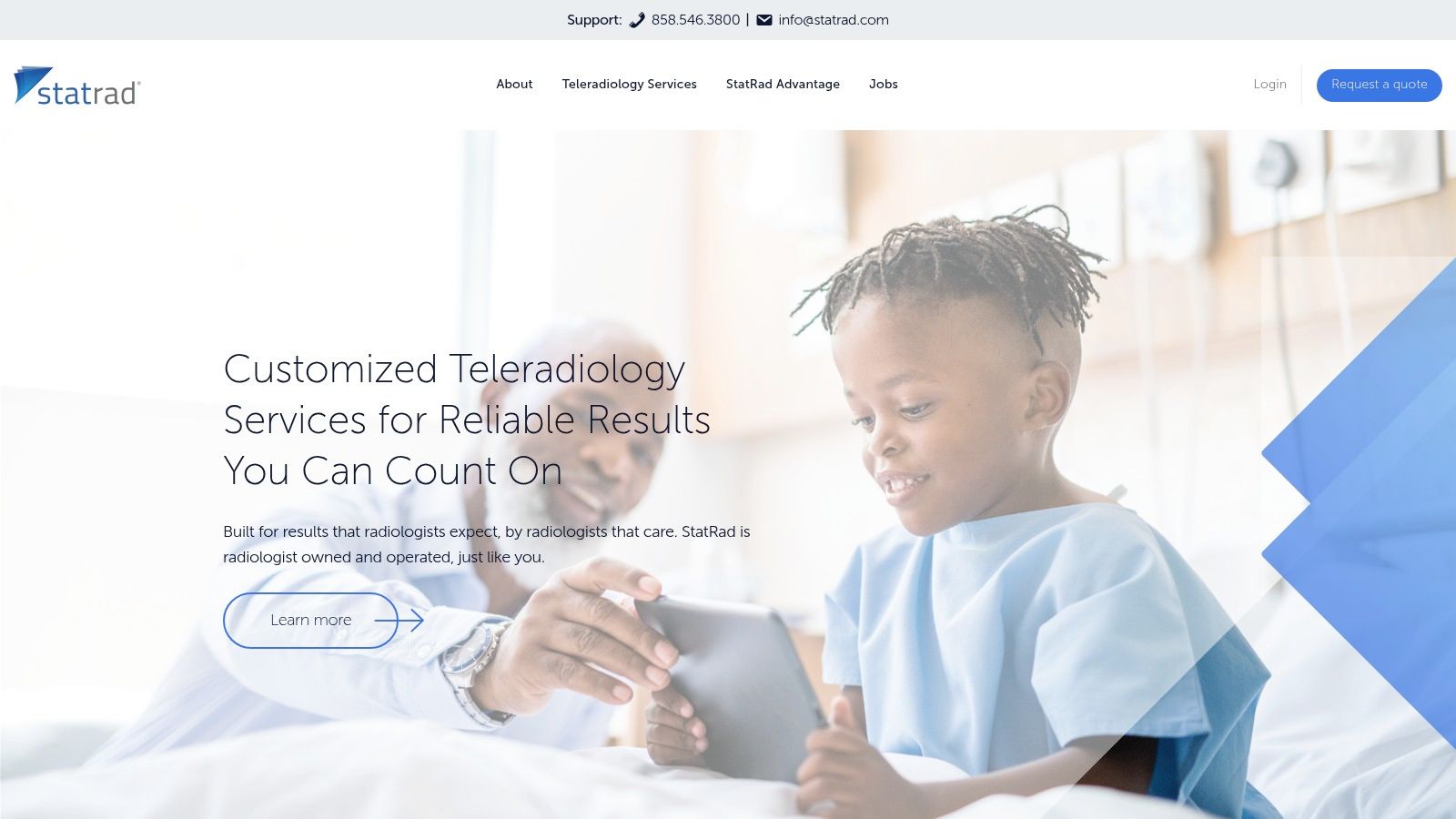
StatRad’s distinction lies in its proprietary software platform, which enables highly customizable workflows and provides transparent reporting on key performance metrics like turnaround times and discrepancy rates. This level of transparency and customizability allows clients to maintain control over their imaging services while benefiting from outsourced expertise. Its strong reputation for quality and established partnerships with major health systems make it a reliable choice among leading teleradiology companies.
Key Considerations
Service Model: Offers final and preliminary reads with a focus on being an integrated partner for existing groups.
Security: Emphasizes high security standards to protect patient data and ensure HIPAA compliance.
Pricing: Custom pricing is provided through enterprise contracts; no public pricing is available.
Implementation: Requires a consultative onboarding process to establish custom workflows and system integration.
Website: https://www.statrad.com
5. ONRAD
ONRAD stands out by combining Joint Commission-accredited teleradiology services with flexible onsite staffing solutions. This hybrid approach allows hospitals and imaging centers to create a custom radiology program that addresses both remote and in-person coverage needs. The group provides 24/7/365 preliminary and final interpretations, including subspecialty reads like TeleMammography, ensuring comprehensive support around the clock.
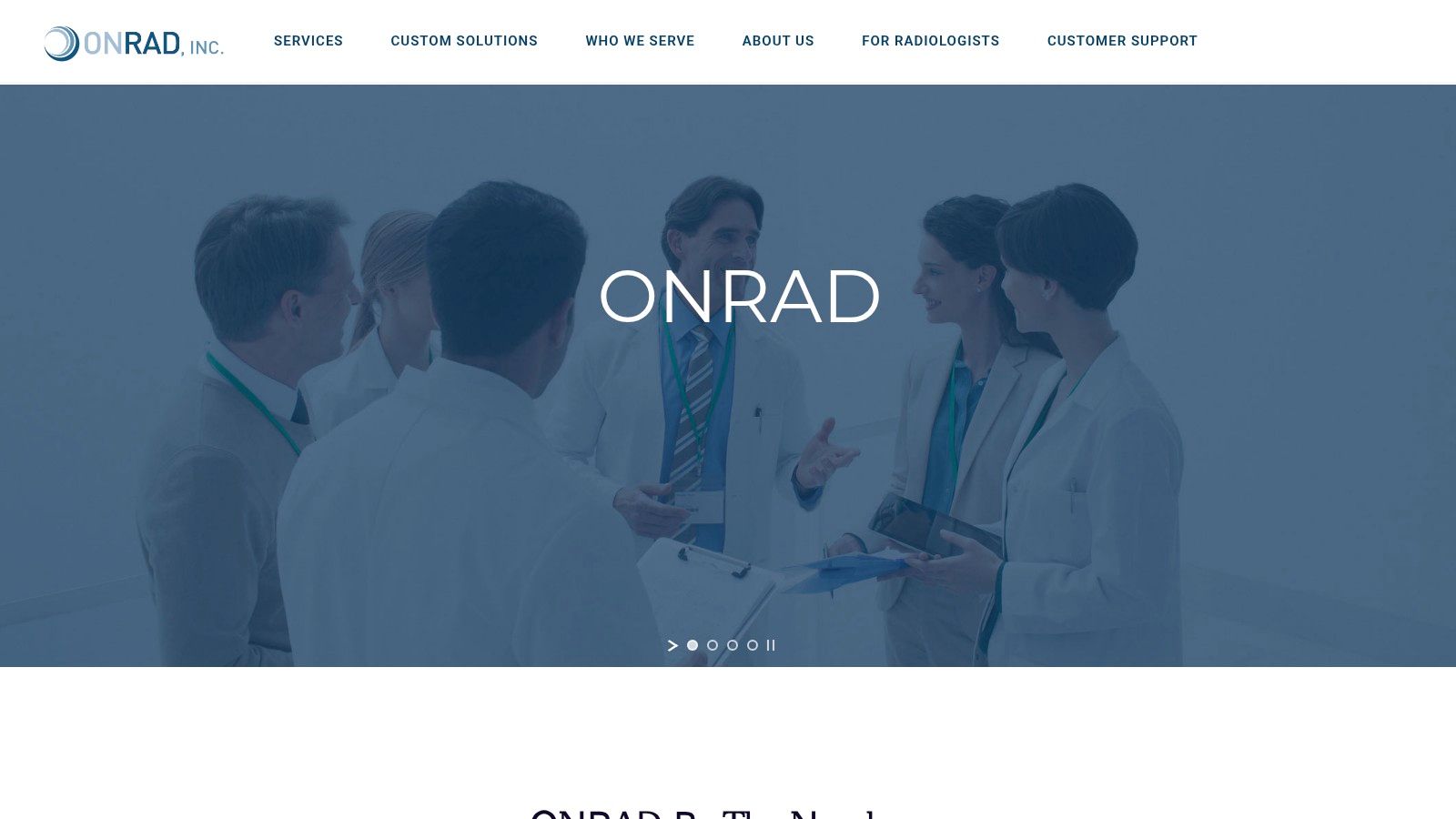
A key differentiator for ONRAD is its commitment to transparency, publicly sharing its monthly turnaround time and quality assurance metrics. This focus on verifiable performance helps build trust and allows clients to assess service levels directly. This level of accountability, along with its long accreditation track record, positions ONRAD as one of the fastest growing teleradiology companies in 2025. By addressing the critical need for reliable communication in remote diagnostics, ONRAD exemplifies the importance of streamlined healthcare communications for modern practices.
Key Considerations
Service Model: Offers a hybrid of teleradiology and onsite staffing with final and preliminary reads.
Security: As a Joint Commission-accredited group, it adheres to stringent quality and patient safety standards.
Pricing: Custom pricing based on scope and service level agreements; no public pricing is available.
Implementation: Requires a formal contract outlining service scope, which may involve a detailed negotiation and setup process.
Website: https://onradinc.com
6. DocPanel
DocPanel introduces a unique marketplace model to the teleradiology landscape, directly connecting healthcare providers and even patients with a network of over 700 U.S.-based, fellowship-trained subspecialists. This platform is particularly well-suited for obtaining expert second opinions, handling specialty-specific overflow, or securing reads for complex cases without a long-term contract. Its flexibility allows facilities to access expertise on a per-case basis, making it a cost-effective solution for practices that need occasional subspecialty support.
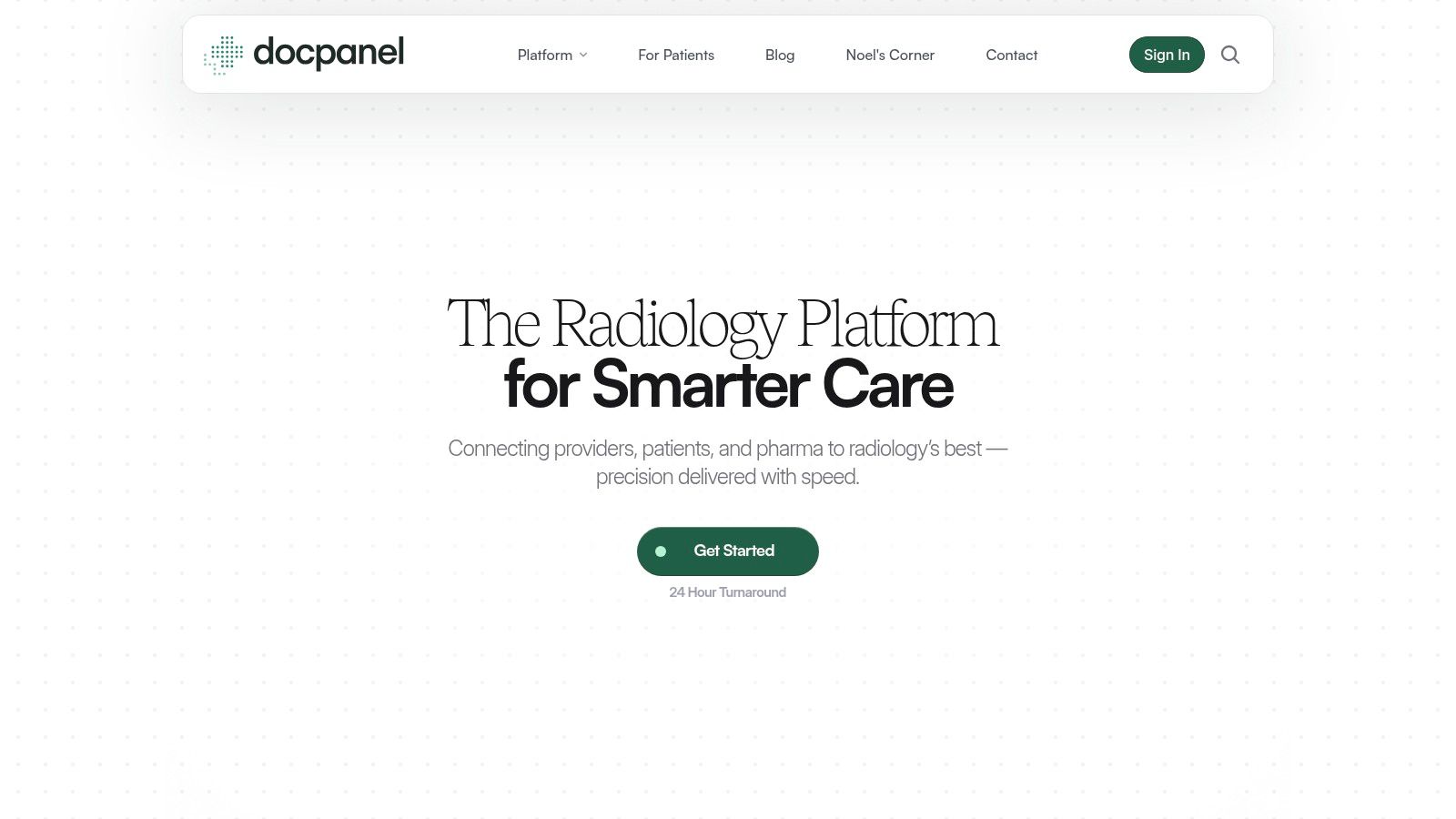
What sets DocPanel apart is its consumer-facing approach, offering transparent pricing directly to patients seeking second opinions, starting at $199 per read. For facilities, it provides a streamlined way to access multi-state licensed radiologists, with DocPanel managing administrative burdens like malpractice coverage. This on-demand access and clear pricing structure position it as one of the most agile and fastest growing teleradiology companies in 2025, especially for organizations looking to supplement their existing radiology services.
Key Considerations
Service Model: Offers on-demand final reads, second opinions, and subspecialty consultations.
Security: HIPAA-compliant platform with secure image and data transfer protocols.
Pricing: Transparent, per-case pricing for patients is published online; enterprise pricing for facilities requires a separate consultation.
Implementation: Geared for quick, per-case access, though facility-level integration requires separate contracting and setup.
Website: https://www.docpanel.com
7. Rapid Radiology
Rapid Radiology has carved out a niche among teleradiology companies by focusing on accessibility and operational flexibility for a diverse range of clients. The company provides 24/7/365 preliminary and final reads to hospitals, emergency rooms, imaging centers, and mobile providers, ensuring consistent coverage without imposing restrictive financial commitments. Its key differentiator is a highly accessible service model that includes no setup fees, no minimum volume requirements, and no upcharges for STAT reads, making it an attractive option for smaller practices and facilities with fluctuating needs.
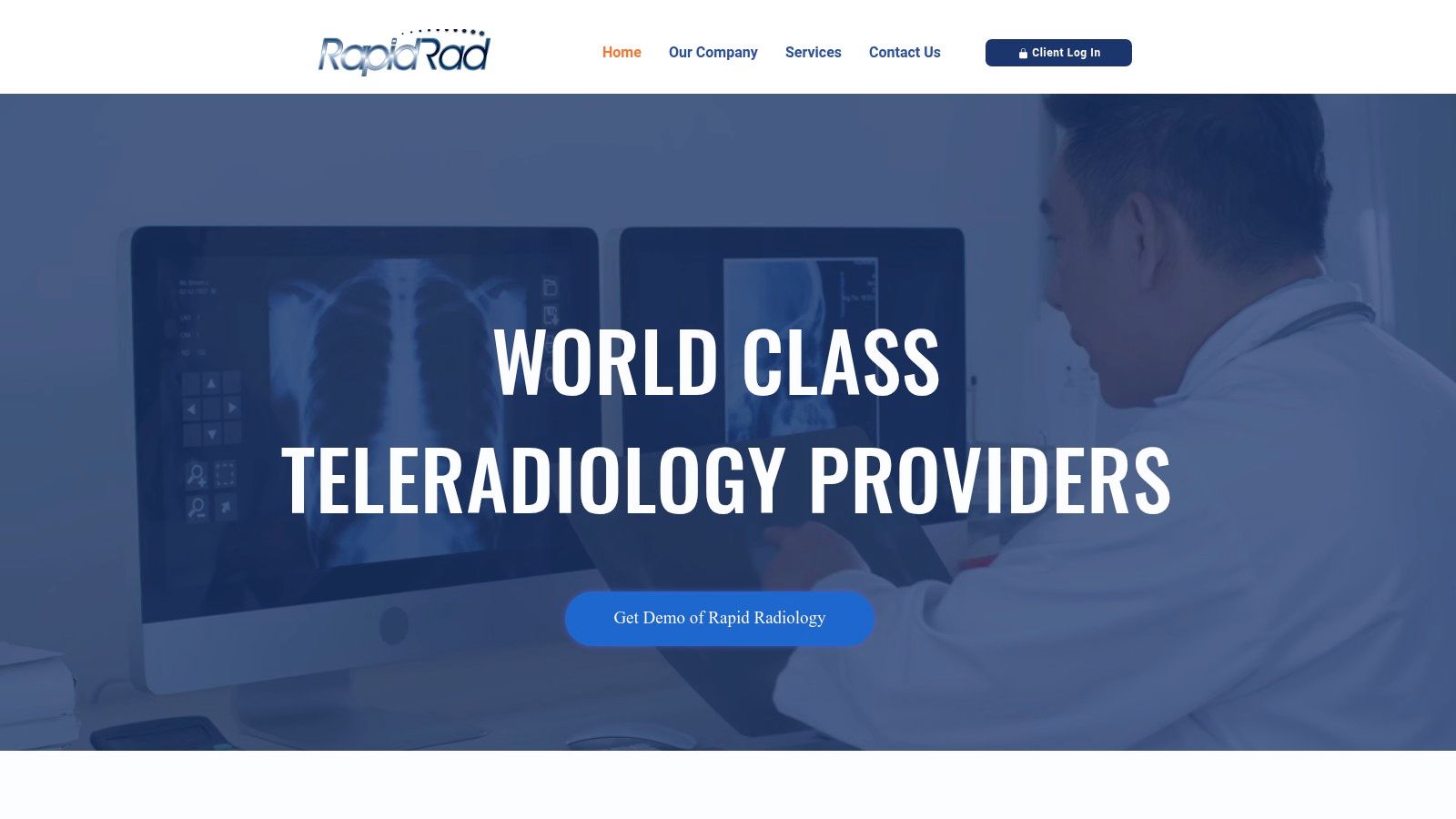
The platform supports seamless workflow integration through HL7 technology and provides in-house credentialing support to expedite the onboarding process. Direct consultations with radiologists are readily available, fostering clear communication and collaboration. This client-centric approach, combined with a robust quality assurance program, positions Rapid Radiology as one of the fastest growing teleradiology companies for healthcare providers seeking a transparent and scalable partnership. It delivers a reliable service without the complex contractual obligations common elsewhere in the industry.
Key Considerations
Service Model: Offers final and preliminary reads with no minimums or setup costs.
Security: Complies with HIPAA standards to ensure patient data protection.
Pricing: Custom pricing is provided via a quote or demo; no public pricing is listed.
Implementation: In-house credentialing support aims to simplify and accelerate the onboarding timeline.
Website: https://www.rapidradiology.com
8. Teleradiology Specialists
Teleradiology Specialists carves out a niche by focusing on the ambulatory care market, providing tailored reading services for urgent care centers, clinics, and outpatient imaging facilities. The company offers interpretations from U.S. board-certified physicians, with a focus on delivering reliable and timely results for x-ray and cross-sectional imaging. Its service model is designed to integrate smoothly into the faster-paced, high-volume workflows common in non-hospital settings, making it a valuable partner for clinics needing dependable diagnostic support.
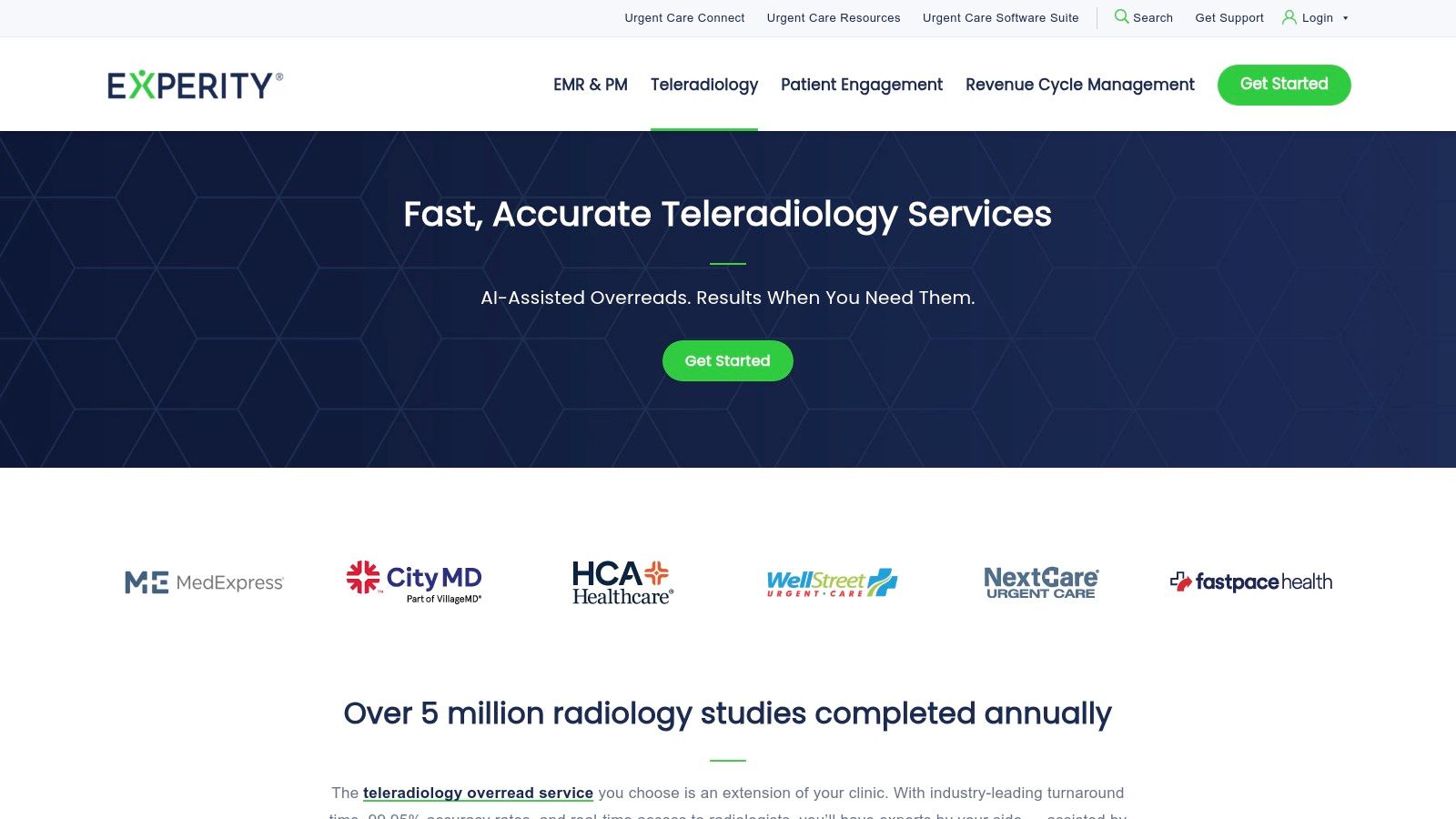
The platform stands out with its customized solutions and responsive, smaller-team approach, which allows for more personalized service and flexible arrangements. This agility can be particularly beneficial for smaller practices that may not require the large-scale enterprise solutions offered by bigger teleradiology companies. While detailed information on enterprise-level integrations is limited, its focus on core ambulatory needs positions it as one of the fastest growing teleradiology companies in 2025 for this specific market segment. For more on this, you can learn about teleradiology services and specialists in our complete guide.
Key Considerations
Service Model: Primarily serves urgent care, clinical, and outpatient settings with final reads.
Security: Follows HIPAA-compliant protocols for data transmission and storage.
Pricing: Offers competitive pricing structures targeted at the urgent care and clinic market; quotes are customized.
Implementation: Geared for simpler integrations, though clients should verify compatibility with their existing PACS and EMR systems.
Website: https://www.teleradiologyspecialists.com
9. All-American Teleradiology
All-American Teleradiology carves out a niche by focusing exclusively on daytime, subspecialty coverage for outpatient imaging centers and orthopedic groups. With services available in 26 states, it provides U.S.-based, fellowship-trained radiologists specializing in high-demand areas like musculoskeletal (MSK), neuroradiology, and mammography. This targeted approach is ideal for facilities that need expert-level interpretations for MRI, CT, and ultrasound but do not require 24/7 or STAT emergency reads.

The company differentiates itself with a commitment to stable, predictable coverage and low radiologist turnover, fostering consistent partnerships with clients. All-American Teleradiology is also notably transparent about its robust cybersecurity measures and HIPAA compliance, a critical factor for partners handling sensitive patient data. This dedication to security and specialized expertise makes it one of the more focused teleradiology companies for practices prioritizing daytime quality and consistency. Its targeted service model makes it a notable and growing player in 2025.
Key Considerations
Service Model: Provides final daytime reads with a strong emphasis on subspecialties like orthopedics.
Security: Publicly communicates strong HIPAA and cybersecurity initiatives.
Pricing: Custom quotes are available upon consultation with their team.
Implementation: Geographic limitation is a key factor; coverage is currently restricted to 26 states, making it unsuitable for national practices.
Website: https://www.allamericanrad.com
10. National Diagnostic Imaging (NDI)
National Diagnostic Imaging (NDI) offers a straightforward, U.S.-based teleradiology service focused on providing HIPAA-compliant off-site reads for healthcare facilities. The platform stands out for its accessible intake process, which uses phone and email for rapid onboarding, making it an attractive option for smaller or mid-size centers needing quick setup and reliable interpretations. NDI covers a broad spectrum of modalities and subspecialties, ensuring that clients can get expert reads without complex technical overhead.
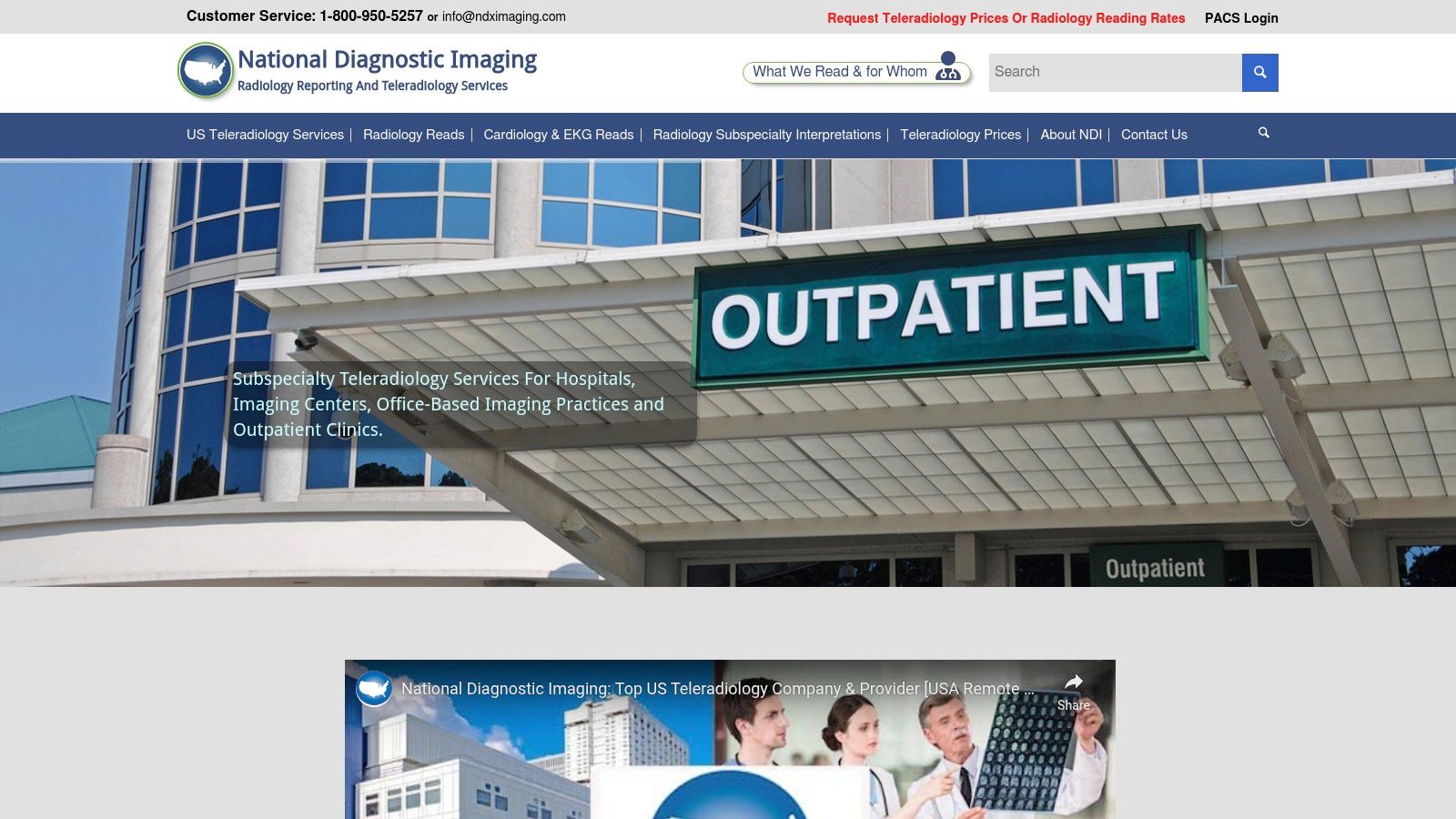
This simple access model is central to NDI's value proposition. By prioritizing direct communication over intricate platform integrations, it reduces the barriers to entry for facilities that may lack extensive IT resources. As one of the dedicated teleradiology companies focused on the domestic market, NDI provides a practical solution for outsourcing overflow, after-hours, or subspecialty reading needs. This approach has helped it become one of the fastest growing teleradiology companies in 2025 for its target demographic.
Key Considerations
Service Model: Provides final and preliminary reads with a focus on ease of access.
Security: Operates under strict HIPAA compliance to ensure patient data protection.
Pricing: Custom quotes are provided based on volume and specific service needs.
Implementation: The website provides limited technical details on platform integrations or performance metrics, so prospective clients should inquire directly for specifics.
Website: https://www.ndximaging.com
11. Everlight Radiology
Everlight Radiology operates on a unique radiologist-led, "follow-the-sun" model, leveraging a global network of consultant radiologists across the UK and Australia. This time zone advantage allows them to provide continuous, 24/7 urgent and after-hours reporting without relying on overnight shifts for their staff. Their deep expertise in emergency teleradiology makes them a strong partner for hospitals needing reliable, expert coverage during their most critical hours, ensuring patient care never stops.
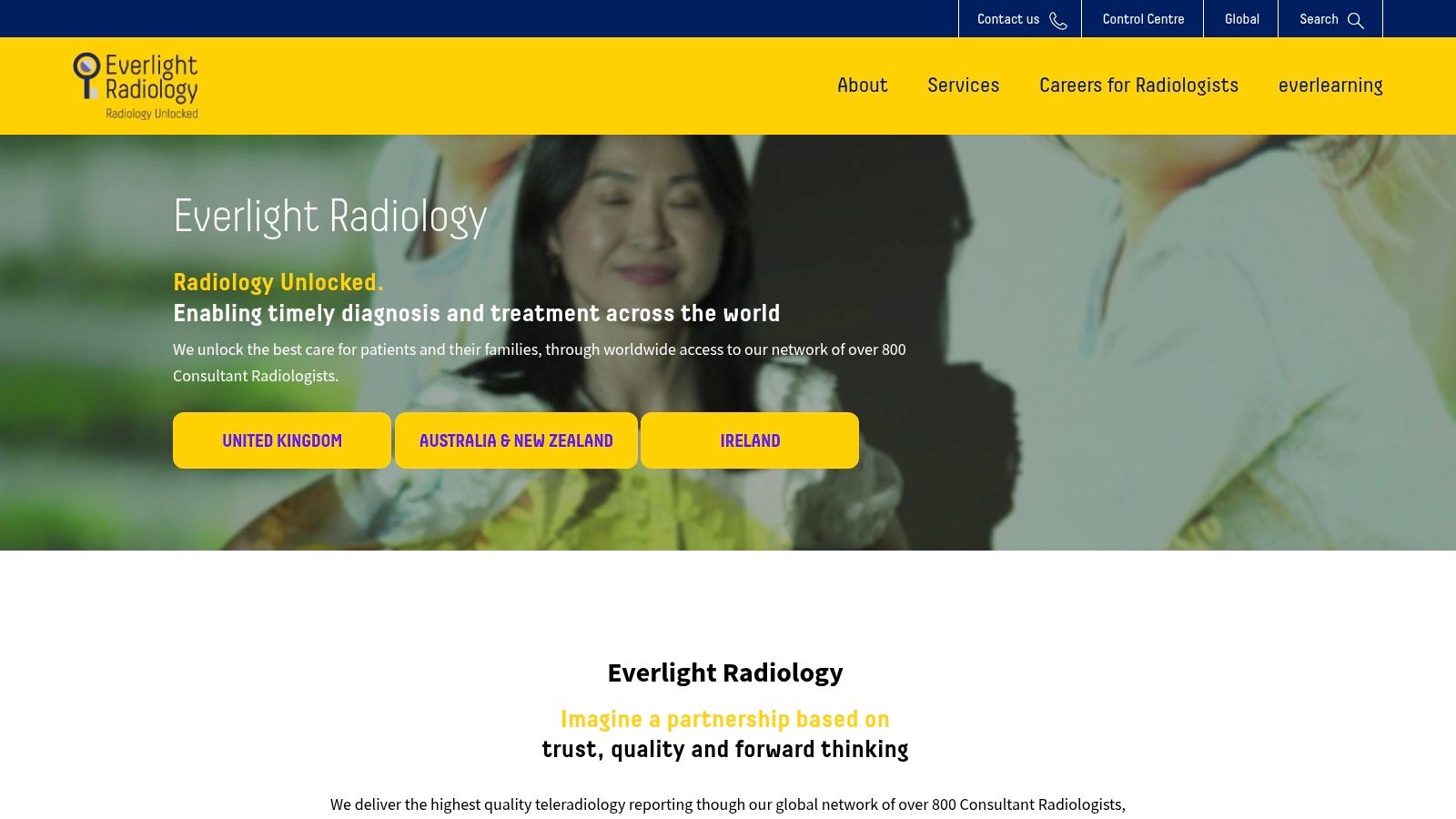
As one of the fastest growing teleradiology companies, Everlight stands out for its strong emphasis on quality assurance and peer review, which is central to its radiologist-led culture. The company actively publishes research on the global radiology workforce and quality metrics, demonstrating a commitment to advancing the field. This focus on clinical excellence, combined with established international partnerships, provides a robust framework for delivering consistent and high-quality diagnostic interpretations.
Key Considerations
Service Model: Specializes in 24/7 emergency, after-hours, and overflow reporting with consultant-level radiologists.
Security: Adheres to international data security standards, though specific compliance may vary by region.
Pricing: Pricing is customized based on service level, volume, and contract terms.
Implementation: U.S.-based clients should anticipate additional credentialing and compliance steps due to the international nature of the radiologist network.
Website: https://www.everlightradiology.com
12. MDW Radiology Marketplace
MDW Radiology Marketplace introduces a decentralized, on-demand model to the teleradiology landscape. It functions as a U.S.-based marketplace connecting healthcare facilities directly with over 400 licensed, board-certified radiologists, cardiologists, and neurologists. This flexible approach is ideal for organizations needing immediate overflow support, niche subspecialty interpretations, or a way to trial teleradiology services without long-term commitments. The platform allows users to send single studies or large volumes, matching them with qualified readers based on state licensure.
The key differentiator for MDW is its transparent, fee-per-read structure and lack of upfront costs. Facilities can access credentialing documents and negotiate rates directly, providing significant control over spending and partnerships. This model eliminates the implementation fees and lengthy contracts typical of larger teleradiology companies. Its direct-access framework and adaptability make it a notable platform for facilities looking for agile and cost-effective coverage solutions, positioning it among the fastest growing teleradiology companies in 2025.
Key Considerations
Service Model: A direct marketplace for on-demand preliminary or final reads across multiple specialties.
Flexibility: No sign-on fees or long-term contracts; pay-per-read pricing is negotiable.
Pricing: Transparent wholesale pricing is set by individual radiologists, allowing for competitive negotiation.
Implementation: Buyer assumes responsibility for vetting radiologists, as marketplace quality and pricing can vary.
Website: https://mdw.io
Key Feature Comparison of Top 12 Teleradiology Companies
Provider | Core Features | Quality & User Experience | Value Proposition | Target Audience | Price Points |
|---|---|---|---|---|---|
RAD365 | 24/7 global coverage; AI-driven workflow; certified US/UK radiologists | 99.99% accuracy; fast turnaround (15 min emergency, 2 hr standard); HIPAA compliant | Innovative AI integration; reliable emergency & second opinion services | Hospitals, imaging centers, providers worldwide | Pricing on request |
vRad (Virtual Radiologic) | 500+ subspecialty radiologists; HL7/FHIR integration; SOC 2 Type II security | Proven scale & stability; 24/7 U.S. ops center | Comprehensive support: billing, credentialing | Large healthcare orgs needing broad teleradiology | Pricing on request |
USARAD (Radiology-On-Demand) | Customizable schedules; AI-supported workflow; 24/7 nationwide coverage | Radiologist-owned; flexible fractional staffing | Physician-led with subspecialty reads | Healthcare providers needing flexible coverage | Pricing varies by modality |
StatRad | Proprietary platform; 24/7/365 coverage; transparent performance reporting | Strong quality focus; established health system partnerships | Custom workflows with emphasis on security | Radiology groups & health systems | Enterprise contracts required |
ONRAD | 24/7 final/prelim reads; published turnaround & quality metrics; onsite staffing | Long accreditation history; transparent QA focus | Combines teleradiology and onsite staffing | Hospitals, imaging centers | Contract required |
DocPanel | Access to 700+ subspecialists; patient choice; malpractice coverage | Transparent per-case pricing; 1-2 day turnaround | Consumer-friendly marketplace | Patients, facilities needing second opinions | Patient pricing from $199 |
Rapid Radiology | Nationwide finals/prelims; in-house credentialing; HL7 integration; QA program | No setup fees; no upcharge for STAT reads | Broad client segments; easy onboarding | Hospitals, ERs, imaging centers | Pricing on request |
Teleradiology Specialists | Urgent care focus; US board-certified radiologists; customizable solutions | Responsive small team; competitive pricing | Tailored for urgent care & clinics | Urgent care centers, clinics | Competitive pricing |
All-American Teleradiology | Fellowship subspecialists; cybersecurity focus; daytime coverage in 26 states | Transparent security focus; low staff turnover | Strong orthopedic and outpatient imaging focus | Outpatient imaging, orthopedic centers | Not disclosed |
National Diagnostic Imaging (NDI) | Wide modality coverage; HIPAA compliant; phone/email intake | Simple, rapid onboarding | Focused on smaller/mid-size US centers | Small and mid-size facilities | Not disclosed |
Everlight Radiology | 24/7 global coverage; onshore/offshore time zone advantage | Radiologist-led; strong QA culture | Expertise in overnight and emergency reads | Global hospitals needing overnight coverage | Not disclosed |
MDW Radiology Marketplace | 400+ board-certified radiologists; no fees; state-based matching | Flexible on-demand reads; transparent pricing docs | Marketplace model for overflow and niche reads | Facilities needing flexible, trial, or overflow coverage | Negotiable per read |
Final Thoughts
Navigating the landscape of teleradiology companies can feel overwhelming, but making an informed choice is critical for enhancing patient care, improving operational efficiency, and managing costs. This guide has dissected some of the fastest-growing and most established players in the field for 2025, from large-scale national providers like vRad and USARAD to innovative marketplaces like DocPanel and MDW Radiology Marketplace. Each company offers a distinct value proposition tailored to different clinical needs, organizational sizes, and strategic goals.
The key takeaway is that there is no single "best" teleradiology company; the right partner is the one that aligns perfectly with your specific requirements. A rural hospital needing consistent 24/7/365 preliminary reads for its emergency department has vastly different needs than an outpatient imaging center seeking subspecialty expertise for complex orthopedic or neurological cases. Your selection process must be driven by a deep understanding of your own operational workflows, patient demographics, and long-term growth objectives.
Key Considerations Before Making Your Decision
Before you sign a contract, reflect on the crucial factors discussed throughout this article. A successful partnership hinges on more than just turnaround times and pricing. Consider the following strategic points:
Integration and Workflow: How seamlessly will the teleradiology platform integrate with your existing RIS, PACS, and EMR systems? A cumbersome integration can create significant friction for your staff, negating any potential efficiency gains. Ask for detailed implementation plans and case studies from facilities with similar IT infrastructures.
Radiologist Quality and Subspecialty Access: Scrutinize the provider's radiologist credentialing process. Do they have the specific subspecialty coverage you need, not just now but in the future? Access to fellowship-trained radiologists can be a powerful differentiator for your practice.
Scalability and Flexibility: Your needs may change. Does the provider offer flexible contract terms that allow you to scale services up or down? Look for partners that can grow with you, whether that means adding new modalities, expanding service hours, or providing support for a new facility.
Compliance and Security: Ensure the company demonstrates robust adherence to HIPAA, HITECH, and other regulatory standards. Data security is non-negotiable, so inquire about their cybersecurity measures, data encryption protocols, and disaster recovery plans.
Ultimately, selecting from the many available teleradiology companies is a strategic decision that extends far beyond a simple vendor relationship. It's about finding a partner committed to quality, reliability, and clinical excellence. Use this guide as a starting point, conduct thorough due diligence, and choose the provider that will become a true extension of your clinical team, helping you deliver superior patient outcomes well into the future.
Ready to see how a next-generation teleradiology platform can transform your practice? Explore RAD365 to discover our AI-powered workflow automation, seamless integration capabilities, and access to a world-class network of subspecialist radiologists. Visit RAD365 to schedule a personalized demo and learn how we are defining the future of radiology services.
